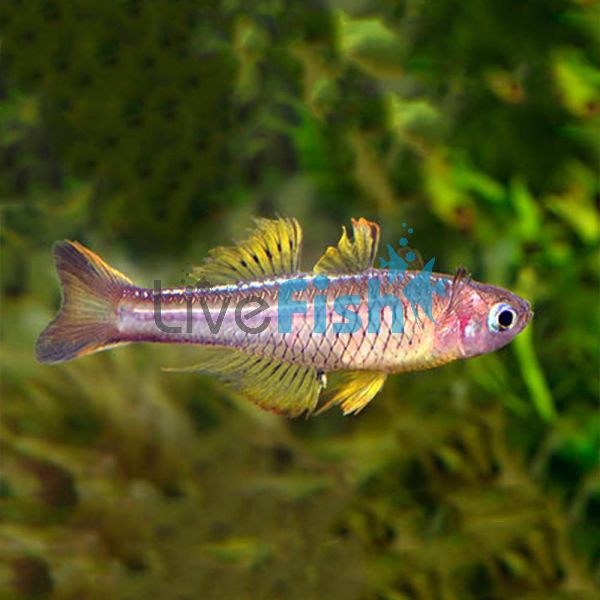Ivantsoff's Blue Eye 2cm - N.G
For pseudomugil collectors or an aquarist looking for something a bit rare and different, Ivanstoff’s blue eye would be the perfect fish for you. Blue eyes are a fantastic nano rainbowfish consideration because of their flashy aesthetic, small size, and relatively hardy nature. The Ivanstoff’s blue eye is native to Papua New Guinea which seems to be a hotspot for the most vibrant coloured rainbowfish. These fish are named after Walter Ivantsoff of Macquarie University, Australia for his contributions to atherinoid fish taxonomy. This blue eyes species will make for an absolutely stunning species in a nano-planted tank because of bright and vibrant they are.
- Buy 4 for $42.81 each and save 10%
- Buy 8 for $40.43 each and save 15%
- Buy 12 for $38.06 each and save 20%
Ivantsoff's Blue Eye - N.G
For pseudomugil collectors or an aquarist looking for something a bit rare and different, Ivanstoff’s blue eye would be the perfect fish for you. Blue eyes are a fantastic nano rainbowfish consideration because of their flashy aesthetic, small size and relatively hardy nature. The Ivanstoff’s blue eye is native to Papua New Guinea which seems to be a hotspot for the most vibrant coloured rainbowfish. These fish are named after Walter Ivantsoff of Macquarie University, Australia for his contributions to atherinoid fish taxonomy. This blue eyes species will make for an absolutely stunning species in a nano-planted tank because of bright and vibrant they are.
The Ivantsoff’s blue eye is one of the smallest rainbow species meaning they max out at around 3 - 4 cm. Part of their beauty is the simplicity of their colours with almost a pastel palette. The body colour starts off with a lavender purple and transitions to a light yellow near the body which returns back to lavender near beyond the ventral fin. This purple is deeper in the tail and contested with a brighter sulphur yellow in all the other fins. Finally, the most characteristic factor of this fish which is the Fluro blue colour of the eye which earns the name blue eye. These fish display amazingly when kept in schools and are easily bred in the home aquarium given the right conditions. T
Once they reach maturity; blue eyes will breed on an almost daily basis. Though you can simply leave the parents in a dedicated planted display aquarium and hope for the fry to survive, the best luck is achieved when setting up a breeding system. Aquarists will usually have these fish in a bare aquarium with spawning mops which are rotated out daily to harvest the eggs which can then be hatched elsewhere. Males tend to have much more vibrant fins and are generally larger than females. Females will almost always be a blander colour but still beautiful fish in their own right.
Tank Recommendations for your Ivantosff’s Blue Eye
Being a small and relatively easy to care for fish, the Ivantsoff’s blue eye can be kept in nano aquariums with the minimum being a 37-liter system. These fish are mostly middle-to-top dwellings and will appreciate a longer tank to supplement their active behaviour. A tight-fitting lid is also required because Ivantstoff’s blue eyes have a high risk of jumping out. Though the hardscape and substrate are not a major concern, these fish will absolutely love a planted tank. These are also tropical fish that are best kept between 24 - 28 degrees.
Suitable Tank Buddies
Being a small and peaceful fish, the Ivantsoff’s blue eye is a very easy fish to pair with other tank mates. They can be kept in aquariums with other dwarf rainbow fish or in mixed community aquariums.
Usually Compatible
Pseudomogil species such as forktail, neon, and delicate blue eyes along with other small community fish like tetras, rasboras, and similar species.
Sometimes Compatible
Medium size growing rainbows such as Lacustris rainbows, Murray river rainbows, and peaceful community fish like angelfish or gouramis. There is a risk that the mild territorial behaviour that angelfish or similar species display can harm the blue eyes over a period of time.
Rarely Compatible
Large and aggressive species which would prey on the Ivantsoff’s blue eye such as Oscars, or jaguar cichlids.
Feeding your Ivantsoff’s Blue Eye
The Ivantsoff’s blue eye is very easy to feed once it is settled into the aquarium. It will readily eat a wide range of foods but would prefer to have high-protein foods like frozen bloodworms, Mysis shrimp or live foods such as brine shrimp or black worms. This however can be easily fed with good-quality flakes or nano-floating pellets.
| Scientific Name | Pseudomugil ivantsoffi |
|---|---|
| Care Level | Easy |
| Common Names | Ivantsoffi’s Blue Eye |
| Diet | Omnivore |
| Fish Family | Melanotaeniidae |
| Lifespan (years) | 5 |
| Max. Length (cm) | 4 |
| Min. Tank Volume (l) | 40 Litres |
| Origin | Indonesia |
| Reef Safe | Yes |
| Sociability | Peaceful |
| Venomous | No |
| Water Conditions | 24-28° C, pH 6.5-7.5 |
-
0Interested in the Ivanstoffi,but want to make sure if purchased would recieve mixed males and femalesRead Detail
 Submited by: Stephen Anthony
Submited by: Stephen Anthony
 12 Dec 2020
12 Dec 2020
-
Thanks for contacting us - our supplier tries to send a 50/50 split however it will depend on what they have on hand Please email when you order and we can add a request noteAnswered by Admin on 03 Jan 2021
-
- 1




